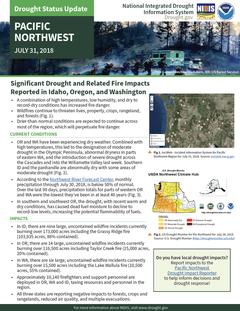Pacific Northwest Drought Status Update - July 31, 2018
Two-page report on July 2018 Pacific Northwest U.S. drought conditions, impacts, and outlook and wildfires.
Significant Drought and Related Fire Impacts Reported in Idaho, Oregon, and Washington
- A combination of high temperatures, low humidity, and dry to record-dry conditions has increased fire danger.
- Wildfires continue to threaten lives, property, crops, rangeland, and forests.
- Drier-than-normal conditions are expected to continue across most of the region, which will perpetuate fire danger.
CURRENT CONDITIONS
- OR and WA have been experiencing dry weather. Combined with high temperatures, this led to the designation of moderate drought in the Olympic Peninsula, abnormal dryness in parts of eastern WA, and the introduction of severe drought across the Cascades and into the Willamette Valley last week. Southern ID and the panhandle are abnormally dry with some areas of moderate drought.
- According to the Northwest River Forecast Center, monthly precipitation through July 30, 2018, is below 50% of normal. Over the last 90 days, precipitation totals for parts of western OR and WA were the lowest they’ve been in at least 40 years (Fig. 3).
- In southern and southwest OR, the drought, with recent warm and dry conditions, has caused dead fuel moisture to decline to record-low levels, increasing the potential flammability of fuels.
IMPACTS
- In ID, there are nine large, uncontained wildfire incidents currently burning over 173,000 acres including the Grassy Ridge fire (103,935 acres, 88% contained).
- In OR, there are 14 large, uncontained wildfire incidents currently burning over 116,500 acres including Taylor Creek fire (25,000 acres, 20% contained).
- In WA, there are six large, uncontained wildfire incidents currently burning over 15,500 acres including the Lake Wallula fire (10,500 acres, 55% contained).
- Approximately 10,140 firefighters and support personnel are deployed in OR, WA and ID, taxing resources and personnel in the region.
- All three states are reporting negative impacts to forests, crops and rangelands, reduced air quality, and multiple evacuations.
Do you have local drought impacts? Report impacts to the Pacific Northwest Drought Impact Reporter to help inform decisions and drought response!
OUTLOOK
- Significant fire potential is expected to be above normal through September. Fire danger indices are near-record values for late July, making recent lightning events very efficient in starting fires. The Pacific Northwest 7-Day Fire Potential Outlook indicates very high risk for new fires in eastern OR due to the threat of lightning and dry, windy conditions.
- The 8-14 Day Outlook shows a chance of above-normal precipitation along the coast with near-normal precipitation across the rest of the region, and near-normal temperatures across much of the region, except for above-normal temperatures in southeast OR.
- The US Seasonal Drought Outlook released on July 19, 2018, shows that drought is expected to persist in OR and southwest WA, and drought development is likely across the rest of the state and the northern panhandle of ID.
Drought Resources
Find your state climatologist: https://stateclimate.org/state_programs/
Fire Information for the Pacific Northwest: www.climatehubs.oce.usda.gov/hubs/northwest/topic/fire-information-northwest
Washington Water Supply Information: ecology.wa.gov/Water-Shorelines/Water-supply/Water-availability/Statewide-conditions
Oregon Department of Water Resources: https://www.oregon.gov/owrd/Pages/index.aspx
Idaho Department of Water Resources: idwr.idaho.gov
Next Update
Drought Status Updates will be issued in the future as conditions evolve.
Drought and Climate Outlook Webinars are offered for regional drought early warning systems (DEWS).


